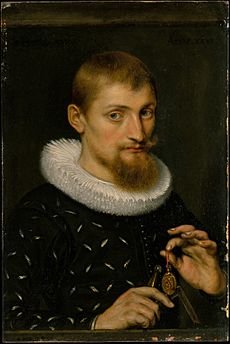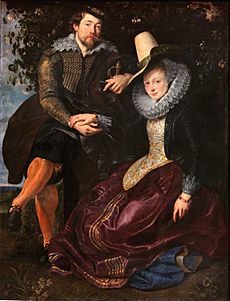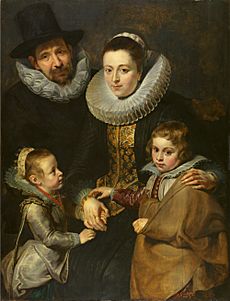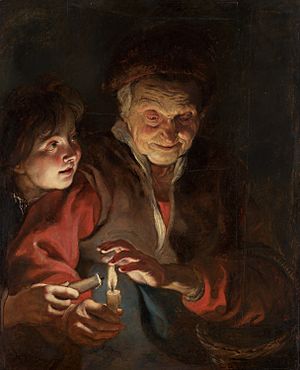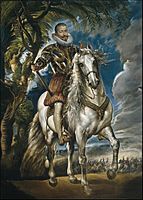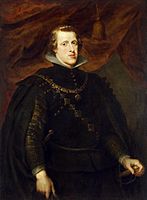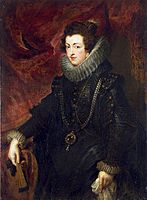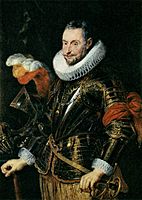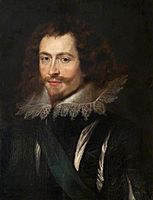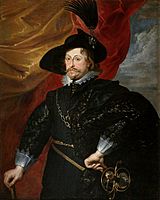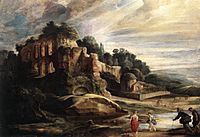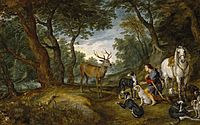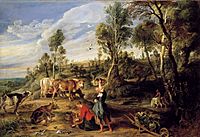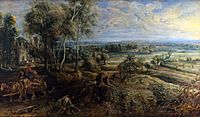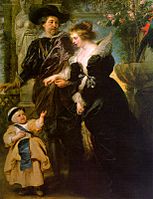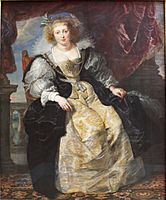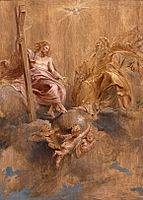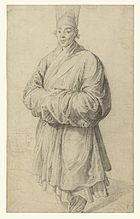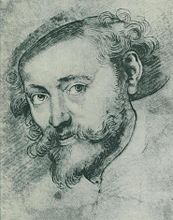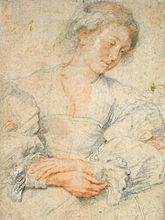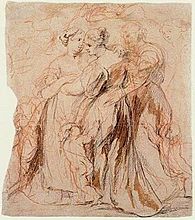Peter Paul Rubens facts for kids
Quick facts for kids
Peter Paul Rubens
|
|
|---|---|
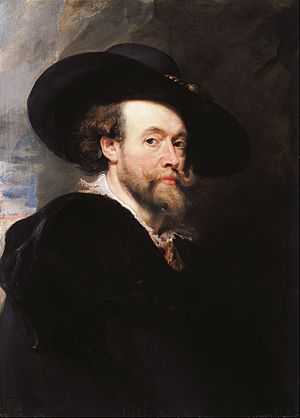
Self-Portrait, 1623, Royal Collection
|
|
| Born | 28 June 1577 Siegen, Nassau-Dillenburg, Holy Roman Empire
|
| Died | 30 May 1640 (aged 62) |
| Nationality | Flemish |
| Education | Tobias Verhaecht Adam van Noort Otto van Veen |
| Known for | Painting, drawing, tapestry design, print design |
| Movement | Flemish Baroque |
| Spouse(s) |
Isabella Brant
(m. 1609; died 1626)Helena Fourment
(m. 1630) |
| Signature | |
 |
|
Sir Peter Paul Rubens (born June 28, 1577 – died May 30, 1640) was a famous artist and diplomat from a region called Flanders, which is now part of Belgium. He is known as the most important artist of the Flemish Baroque style. Rubens's paintings are full of energy and often show stories from ancient Greek and Roman times or from the Bible. His unique style used lots of movement, bright colors, and strong feelings. This style was very popular and fit well with the artistic trends of his time.
Rubens painted many different things. He created large paintings for church altars, portraits of people, beautiful landscapes, and historical scenes. He also designed pictures for tapestries and book covers. Rubens ran a large art workshop in Antwerp, where many paintings were made for important people and art collectors across Europe. He was also a very smart scholar and a skilled diplomat. Because of his talents, he was knighted by two kings: Philip IV of Spain and Charles I of England. Rubens was a very busy artist. A list of his works includes over 1,400 pieces, not counting the many copies made by his workshop.
His most common commissions were history paintings, which included religious stories, myths, and hunting scenes. He also painted portraits, especially of his friends and himself. Later in his life, he painted many landscapes. Rubens designed tapestries and prints, and even his own house. He also helped create temporary decorations for royal events in Antwerp. He wrote a book with drawings of palaces in Genoa, Italy, which helped spread that style of building in northern Europe. Rubens loved collecting art and books. He had one of the biggest collections in Antwerp. He also bought and sold art, and sold many important artworks to the Duke of Buckingham. Rubens was one of the last major artists to use wooden panels for his paintings, even for very large ones. He also used canvas, especially for works that needed to travel far. For church altars, he sometimes painted on slate to reduce glare.
Contents
His Life Story
Early Years and Family
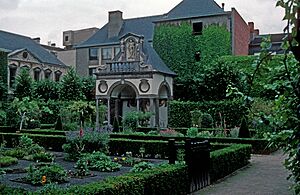
Peter Paul Rubens was born in Siegen. His parents, Jan Rubens and Maria Pypelincks, had left Antwerp in 1568. They moved because of religious problems and the persecution of Protestants during that time. Rubens was baptized in Cologne, Germany.
His father, Jan Rubens, worked as a legal advisor. He was briefly imprisoned. Peter Paul Rubens was born in 1577. The family returned to Cologne the next year. In 1589, after his father died, Rubens moved with his mother to Antwerp. There, he was raised as a Catholic. Religion became a very important part of his artwork. Rubens later became a leading artist for the Catholic Counter-Reformation, a movement that aimed to renew the Catholic Church.
Becoming an Artist
In Antwerp, Rubens received a good education. He studied Latin and classic literature. When he was fourteen, he began learning to paint with Tobias Verhaeght. Later, he studied with two other important painters in the city, Adam van Noort and Otto van Veen. Much of his early training involved copying works by older artists. He copied woodcuts by Hans Holbein the Younger and engravings by Marcantonio Raimondi. Rubens finished his training in 1598. At that time, he became an independent master in the Guild of St. Luke, which was the artists' guild.
Studying in Italy (1600–1608)
In 1600, Rubens traveled to Italy. He first visited Venice, where he saw paintings by famous artists like Titian, Veronese, and Tintoretto. Their use of color and how they arranged their paintings greatly influenced him. He then settled in Mantua, working for Duke Vincenzo I Gonzaga. With the Duke's help, Rubens traveled to Rome in 1601. There, he studied ancient Greek and Roman art. He also copied works by Italian masters like Michelangelo, Raphael, and Leonardo da Vinci. He was also impressed by the realistic paintings of Caravaggio.
Rubens even copied Caravaggio's Entombment of Christ. He also suggested to his patron, the Duke of Mantua, to buy another Caravaggio painting. Later, after returning to Antwerp, Rubens helped acquire a Caravaggio painting for a church there. During his first stay in Rome, Rubens completed his first large church painting. It was for the Santa Croce in Gerusalemme church.
In 1603, Rubens went to Spain on a diplomatic mission. He delivered gifts from the Duke of Mantua to King Philip III. While in Spain, he studied the large art collections of Raphael and Titian. He also painted a portrait of the Duke of Lerma on horseback. This trip was the first of many times in his career where he combined art and diplomacy.
He returned to Italy in 1604 and stayed for four more years. He lived in Mantua, Genoa, and Rome. In Genoa, Rubens painted many portraits. These portraits influenced later artists like Anthony van Dyck.
From 1606 to 1608, he was mostly in Rome. He received a very important commission for the main altar of the Chiesa Nuova church. Rubens's time in Italy continued to influence his work throughout his life. He often wrote letters in Italian and signed his name as "Pietro Paolo Rubens." He always hoped to return to Italy, but he never did.
Back in Antwerp (1609–1621)
In 1608, Rubens heard his mother was ill and planned to return to Antwerp. Sadly, she died before he arrived. His return happened during a good time for Antwerp. A peace treaty was signed in 1609, starting a twelve-year period of peace. In September 1609, Rubens was made court painter for the rulers of the Low Countries.
He was given special permission to keep his studio in Antwerp, instead of at the court in Brussels. This also allowed him to work for other clients. He remained close to the Archduchess Isabella until her death in 1633. She asked him not only to paint but also to act as an ambassador. Rubens further settled in Antwerp when he married Isabella Brant in October 1609. She was the daughter of an important citizen of Antwerp.

In 1610, Rubens moved into a new house and studio that he designed himself. This house is now the Rubenshuis Museum. It was an Italian-style villa in the center of Antwerp. It had his workshop, where he and his students made most of the paintings. It also housed his personal art collection and library, which were among the largest in Antwerp. During this time, he built a large studio with many students and assistants. His most famous student was the young Anthony van Dyck, who later became a leading portrait painter. Rubens often worked with other specialists in the city. For example, Frans Snyders, an animal painter, added the eagle to Rubens's Prometheus Bound. He also often worked with his good friend, Jan Brueghel the Elder, who painted flowers.
Rubens also built another house north of Antwerp, perhaps as an investment.
Large church paintings, like The Raising of the Cross (1610) and The Descent from the Cross (1611–1614) for the Antwerp Cathedral, helped establish Rubens as Flanders' top painter. The Raising of the Cross shows how Rubens combined ideas from other artists with his own style. This painting is seen as a great example of Baroque religious art.
Rubens also used prints and book title pages to spread his fame across Europe. He worked with his friend Balthasar Moretus, who owned a large publishing house. In 1618, Rubens got special permission to protect his designs in France, the Southern Netherlands, and the United Provinces. He hired artists like Lucas Vorsterman to make engravings of his paintings. Rubens also designed the last important woodcuts before the 19th century.
Diplomatic Missions (1621–1630)
In 1621, the Queen Mother of France, Marie de' Medici, asked Rubens to paint two large series of paintings. These paintings celebrated her life and the life of her late husband, Henry IV. They were for the Luxembourg Palace in Paris. The first series, called the Marie de' Medici cycle, was finished in 1625. He started the second series, but it was never completed.

After the Twelve Years' Truce ended in 1621, the Spanish rulers asked Rubens to go on many diplomatic missions. In 1622, while in Paris for the Marie de' Medici cycle, Rubens also gathered secret information. This was an important part of a diplomat's job back then. Between 1627 and 1630, Rubens was very busy as a diplomat. He traveled between the courts of Spain and England. He tried to bring peace between the Spanish Netherlands and the Dutch Republic. He also made several trips to the northern Netherlands as both an artist and a diplomat.
At the royal courts, some people thought that nobles should not work with their hands in art or trade. However, many people treated him as a gentleman. King Philip IV of Spain made Rubens a nobleman in 1624. King Charles I of England knighted him in 1630. Philip IV confirmed Rubens's knighthood a few months later. Rubens also received an honorary Master of Arts degree from Cambridge University in 1629.
Rubens stayed in Madrid for eight months in 1628–1629. Besides his diplomatic talks, he painted several important works for King Philip IV and other clients. He also spent time studying and copying paintings by Titian. During this visit, he became friends with the court painter Diego Velázquez. They planned to travel to Italy together, but Rubens returned to Antwerp alone.
His stay in Antwerp was short. He soon traveled to London and stayed there until April 1630. An important painting from this time is the Allegory of Peace and War (1629). This painting shows Rubens's strong desire for peace. He gave it as a gift to King Charles I.
While Rubens's fame grew internationally, he and his workshop also continued to paint large works for local clients in Antwerp. A good example is the Assumption of the Virgin Mary (1625–26) for the Antwerp Cathedral.
Later Years (1630–1640)
Rubens spent his last ten years mostly in and around Antwerp. He still worked on major projects for foreign clients, like the ceiling paintings for the Banqueting House in London. But he also started exploring more personal artistic ideas.
In 1630, four years after his first wife Isabella died, the 53-year-old painter married his first wife's niece, 16-year-old Hélène Fourment. Hélène inspired the beautiful, full figures in many of his paintings from the 1630s. These include The Feast of Venus and The Three Graces. In The Judgement of Paris, painted for the Spanish court, viewers recognized his young wife as the goddess Venus.
In 1635, Rubens bought a country estate outside Antwerp called the Steen. He spent a lot of time there. His landscapes, like The Château Het Steen with Hunter, show a more personal side of his later work. He also found inspiration in the works of older Dutch artists like Pieter Bruegel the Elder.
Death and Burial
Rubens died on May 30, 1640, from heart failure caused by a long-term illness called gout. He was buried in the Saint James' Church in Antwerp. A special burial chapel was built in the church for him and his family. The chapel was finished in 1650. It has a marble altar with two columns framing an altarpiece painted by Rubens himself. This painting shows the Virgin Mary and saints. In the upper part of the altar is a marble statue of the Virgin Mary, likely made by Lucas Faydherbe, one of Rubens's students. Rubens's second wife, Helena Fourment, and two of her children were also buried in the chapel later. Over the centuries, about 80 of Rubens's descendants were buried there.
Rubens's epitaph, a message written in Latin by his friend Gaspar Gevartius, was carved into the chapel floor. It compares Rubens to Apelles, a very famous painter from ancient Greece.
His Art Workshop
Rubens had a large workshop with many apprentices and assistants, which was common at the time. Paintings from his workshop can be grouped into three types: those he painted entirely himself, those he painted partly (mainly faces and hands), and copies made under his supervision from his drawings or oil sketches. It's not always easy to know exactly who were Rubens's students or assistants. This is because, as a court painter, he didn't have to register his students with the Antwerp Guild of Saint Luke.
About 20 students or assistants have been linked to Rubens, though the evidence varies. It's also unclear from old records if someone was a full-time student or an independent artist who sometimes worked with Rubens on specific projects. Anthony van Dyck worked in Rubens's workshop after training with Hendrick van Balen. Other artists who worked with Rubens include Abraham van Diepenbeeck, Lucas Faydherbe, and Erasmus Quellinus the Younger.
Rubens also often hired other artists to paint specific parts of his large compositions. For example, animal painters like Frans Snyders and Paul de Vos would add animals. Still-life artists would add objects. Jacob Jordaens was another artist he often worked with. One of his most frequent collaborators was Jan Brueghel the Younger.
Art Market Success
Rubens's paintings have sold for very high prices. In 2002, his painting Massacre of the Innocents sold for about $76.2 million. This was a record price for an Old Master painting at the time. In 2012, his Portrait of a Commander sold for about $13.5 million.
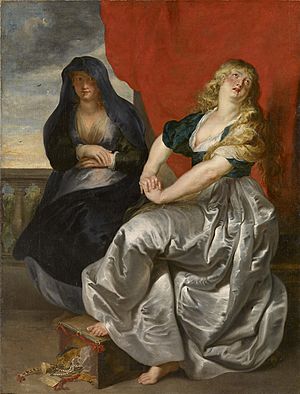
Exhibitions of His Work
Rubens's art has been shown in many important exhibitions around the world:
- 1936: Rubens and His Times, Paris.
- 1997: The Century of Rubens in French Collections, Paris.
- 2004: Rubens, Palais de Beaux-Arts, Lille.
- 2005: Peter Paul Rubens: The Drawings, Metropolitan Museum of Art, New York.
- 2015: Rubens and His Legacy, The Royal Academy, London.
- 2017: Rubens: The Power of Transformation, Kunsthistorisches Museum, Vienna.
- 2019: Early Rubens, Art Gallery of Ontario Toronto, Fine Arts Museums of San Francisco.
Lost Artworks
Some of Rubens's works have been lost over time due to various reasons like fires or being lost at sea. Here are a few examples:
- The Crucifixion, painted for a church in Rome, was lost at sea after 1821.
- Equestrian Portrait of the Archduke Albert is no longer found.
- Susannah and the Elders is only known from an engraving made in 1620.
- Judith Beheading Holofernes (around 1609) is only known through an engraving from 1610.
- Many works were destroyed during the bombing of Brussels. These included Madonna of the Rosary and Virgin Adorned with Flowers by Saint Anne.
- Several works were destroyed in the Coudenberg Palace fire, such as Nativity and Adoration of the Magi.
- Paintings like Neptune and Amphitrite were destroyed in a fire in Berlin in 1945.
- The Abduction of Proserpine was destroyed in a fire at Blenheim Palace in 1861.
- Crucifixion with Mary, St. John, Magdalen was destroyed in London in 1643 during the English Civil War.
- The Equestrian Portrait of Philip IV of Spain was destroyed in a fire at the Royal Alcázar of Madrid in 1734. A copy exists in the Uffizi Gallery.
- The Lion Hunt was destroyed in a fire at the Musée des Beaux-Arts de Bordeaux.
- An alleged Rubens painting, Portrait of a Girl, owned by Alexander Dumas, was reported lost in a fire.
- Equestrian Portrait of the Duke of Buckingham (1625) was destroyed in a fire in Jersey in 1949.
- Portrait of Philip IV of Spain from 1628 was destroyed in an attack at the Kunsthaus Zürich in 1985.
- The Portrait of George Villiers (around 1625) was thought to be lost for nearly 400 years. It was rediscovered in 2017 in Glasgow, Scotland. Experts confirmed it was the original by Rubens himself.
Famous Works
- Early paintings
- Historical portraits
-
Portrait of George Villiers, 1st Duke of Buckingham, around 1617–1628, Pollok House
-
Portrait of King Władysław IV Vasa of Poland, 1620s, Wawel Royal Castle National Art Collection
- Landscapes
-
The Château Het Steen with Hunter, around 1635–1638, National Gallery, London
- Helena Fourment and related pictures
-
Rubens with Hélène Fourment and their Son Peter Paul, 1639, Metropolitan Museum of Art
- Biblical Scenes
- Drawings
-
Man in Korean Costume, around 1617, black chalk with touches of red chalk, J. Paul Getty Museum
See also
 In Spanish: Pedro Pablo Rubens para niños
In Spanish: Pedro Pablo Rubens para niños


